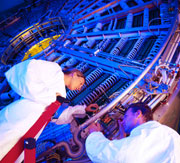Higgs Boson: The Missing Piece?

At long last, scientists announced the discovery of the missing piece to the Standard Model of physics
by Catherine McNiff
 Two scientists checking equipment in the central tube of the LHC. Photo by Antonio Saba courtesy of CERN Related Links |
On July 4, 2012, the physics world and the larger scientific community had a really, really, really tiny reason to celebrate: CERN announced the discovery of a particle "consistent" with the Higgs boson, the missing piece of physics' Standard Model that was first hypothesized in the 1960s. For almost five decades, most physicists have labored under the assumption that the Higgs boson exists; now at long last, there is evidence to prove it.
Of course, scientists had pretty specific ideas about what the Higgs boson might be like. Like many long-awaited and possibly idealized expectations, the elusive particle produced at the large hadron collider (LHC) isn't perfect. While the boson is, as anticipated, 125-126 times the mass of a proton, its process of production and decay is 1 ½-2 times too big. Deviations might prove to be statistical or experimental variances or they may pave the way, as some hope, for another "new physics."
Physicists expect Higgs boson will help unravel the mysteries of matter
Whether or not this new particle is the final piece that completes the Standard Model, or is the first piece in a yet-to-be discovered puzzle, its discovery is exciting and its study will shed light on some of the universe's deepest mysteries, including dark matter, which makes up 90% of the universe; the early life of planets; and the future of the universe, our planet, and us. Over the next decades, study of this Higgs boson will help us not just understand how mass exists, but it might also allow us to "see" things we've only imagined, whether it be inside our Earth or millions of light years away. Mass matters, and that is why the tiny Higgs boson is such a big deal.
The LHC will continue to run through 2012 then will be offline for two years to retool. When the particle accelerator comes back online in 2014, it will have double the power-14 trillion electronvolts-and infinite potential for further discovery.
- More from Science







